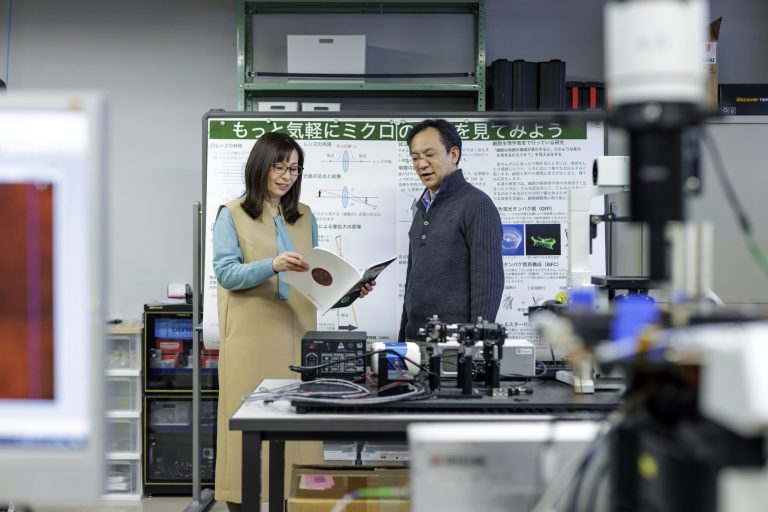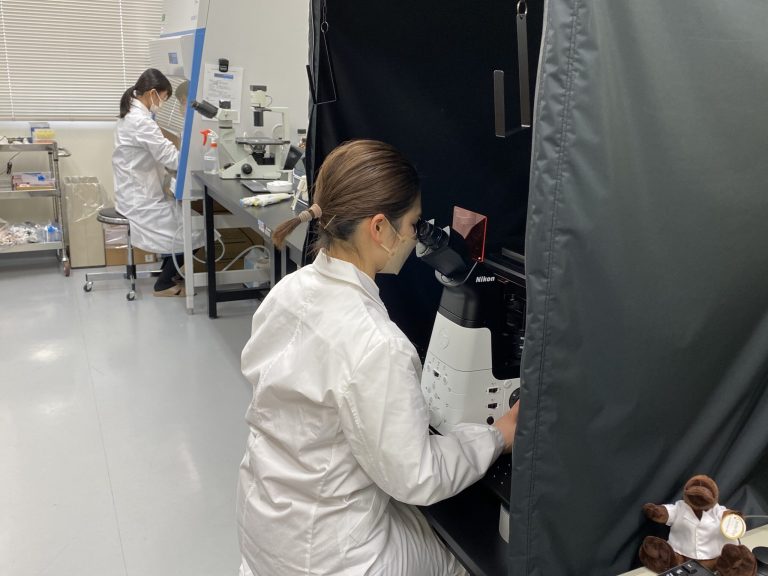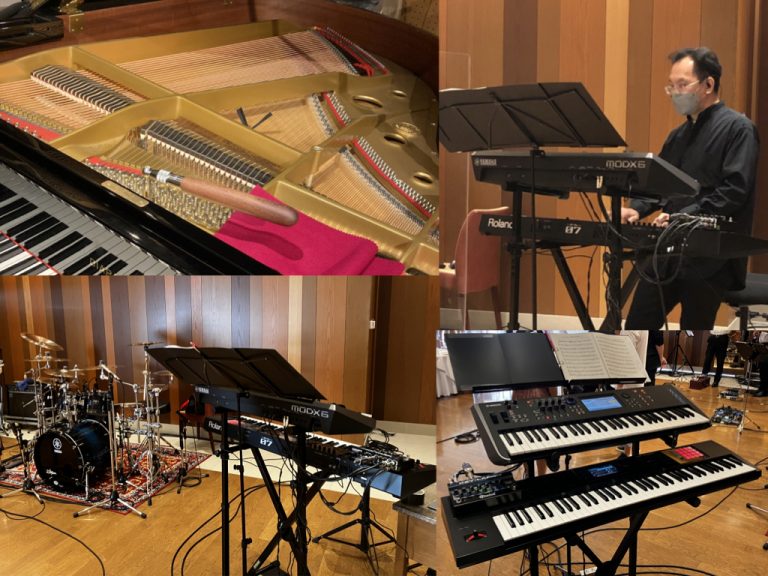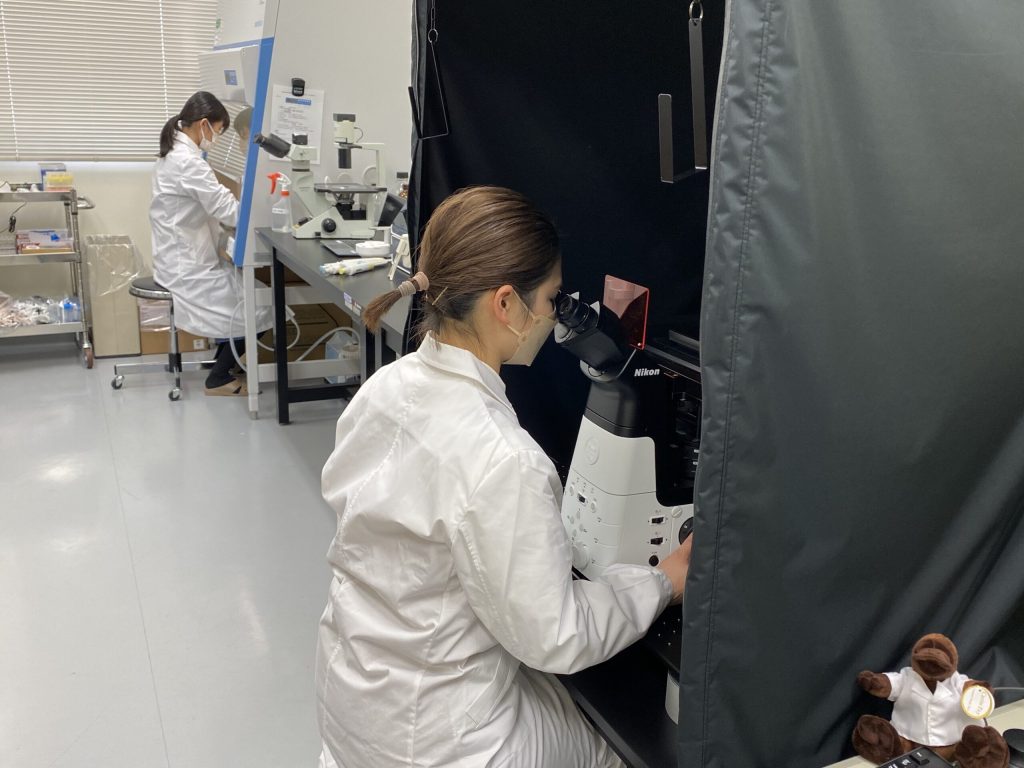This article was published in the Spring 2023 issue of Litterae Populi. The full issue can be found here.

Specially Appointed Associate Professor Maho Amano, a Doctor of Agriculture, completed her Ph.D. at the Department of Applied Biological Chemistry, Graduate School of Agricultural and Life Sciences, The University of Tokyo. She was appointed to the position of Specially Appointed Assistant Professor at the Faculty of Advanced Life Science, Hokkaido University, in 2007. She then became a University Research Administrator, a role that enhances and supports research activities; and thereafter an Assistant Professor at the Faculty of Medicine in 2019. She assumed the position of Lecturer in 2020, and was interviewed for this article during this period. In April 2023, she assumed the position of Specially Appointed Associate Professor.
Professor Yusuke Ohba, a Doctor of Medicine, specializes in cell physiology and bioimaging. He completed his Ph.D. in Pathological Science at the Hokkaido University Graduate School of Medicine. He started his basic medical research as a researcher at the International Medical Center of Japan Research Institute. After working as an Assistant Professor at Osaka University and The University of Tokyo, he became Associate Professor at the Hokkaido University Graduate School of Medicine in 2006. He was appointed to his current position in 2012.
Dr. Amano has been promoting the commercialization of a diagnostic technique developed by Professor Ohba. Their initiative, Opto-diagnostics Pickles to bring light to every patient’s future, has garnered significant public interest, culminating in them being bestowed the highest award by the New Energy and Industrial Technology Development Organization (NEDO) TCP (Technology Commercialization Program: supporting researchers with an entrepreneurial mindset) in March 2021.
Successful deployment of groundbreaking research results in society
Physiology is the study of the basic functions and mechanisms of the body. In particular, physiology is aimed at elucidating the mechanism of homeostasis, the ability to maintain the internal milieu, which is a requisite for people to stay alive. Our bodies are known to be made of 60 trillion cells. Cell physiology seeks to find answers to the question: How is the homeostasis of each and every cell maintained?
Once homeostasis is disrupted, the risk of diseases increases. For instance, chronic myeloid leukemia (CML) is a blood cancer that develops when an abnormal chromosome known as the Philadelphia chromosome forms in hematopoietic stem cells, and the protein BCR-ABL appears in the cells.
While molecular targeted drugs are considered effective for the treatment of CML, it takes months or even more than a year to determine the efficacy of the drug in each patient after the treatment was started. If the drug was found ineffective, different drugs must be used. To solve this problem, Dr. Yusuke Ohba, Professor at the Faculty of Medicine, developed pre-treatment diagnostics for CML therapeutics utilizing fluorescence diagnostic technique, and Dr. Maho Amano, a Specially Appointed Associate Professor in the faculty, has worked to deploy the diagnostics in society.

Professor Ohba has been engaged in medical biology research since 2012 in the Department of Chronophysiology of the Hokkaido University Graduate School of Medicine (currently, Department of Cell Physiology, Faculty of Medicine). Previously, he had been engaged in research at International Medical Center of Japan Research Institute the International Medical Center of Japan Research Institute; Osaka University; and The University of Tokyo, following his graduation from Hokkaido University’s School of Medicine. One of his research focuses has been fluorescence bioimaging, with the goal of applying it to clinical testing. Fluorescence diagnostic technique enables highly sensitive and quantitative measurement of protein interactions and structural changes in living cells by visualizing them using fluorescent protein. Professor Ohba used the fluorescent protein—for which Dr. Osamu Shimomura won the Nobel Prize in Chemistry in 2008—to perform fluorescence bioimaging, and applied that technology to clinical testing for CML. He then developed the opto-diagnostic technique called Pickles (Pickles: Phosphorylation indicator of CrkL en substrate), which allows the evaluation and prediction of the efficacy of molecular targeted drugs for CML, enabling the pre-treatment determination of a drug’s efficacy against specific CML cells. CML cells are isolated from a patient’s bone marrow and Pickles is applied to them; when these cells are treated with different molecular-targeted drugs, CML cells for which the drug is effective appear blue and those for which the drug is ineffective appear yellow. The time required from bone marrow sampling to the determination of drug efficacy is about three days, enabling significantly accelerated confirmation of drug efficacy compared with the current methods. This revolutionary technology makes it possible to verify the efficacy of drugs at a glance—but the unprecedented nature of the technology left clinical testing companies uncertain.
Under these circumstances, to ensure the successful deployment of the opto-diagnostics developed by Professor Ohba in society, Dr. Amano launched a startup at Hokkaido University: Horizon Illumination Lab Optics, Co. Ltd., aka HILO. She had first learned about the research on optodiagnostics while investigating medical research seeds in her role as a University Research Administrator. She reminisces: “I found it puzzling that this remarkable research seed had not seen any progress toward commercialization, so I visited Professor Ohba. I realized that the social application of the technology would require the establishment of a company, but no one was available to take the lead as president. I instinctively wanted to give it a try myself.” She established HILO in August 2021 and serves as its president. At present, she is kept busy with her duties as a Specially Appointed Associate Professor as well as business owner.
Thoughts embodied in the company’s name
HILO is the acronym of Horizon Illumination Lab Optics. Professor Ohba and Dr. Amano say they are aiming to create a society where imaging technology will shine light on each patient’s future and enable them to receive treatment with peace of mind. They are seeking to obtain regulatory approval from the Ministry of Health, Labour and Welfare within five years, and continue on this path toward tailor-made medicine, selecting the optimal treatment for each CML patient.

Dr. Amano likes reading books on non-work-related topics on holidays and before going to bed.
This article was published in the Spring 2023 issue of Litterae Populi. The full issue can be found here.


